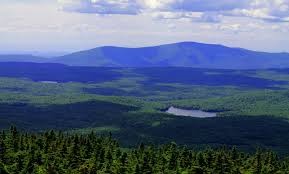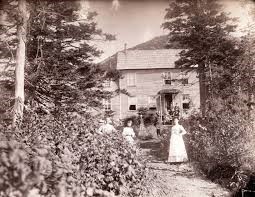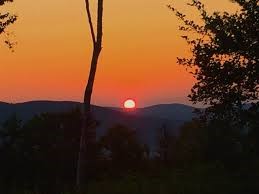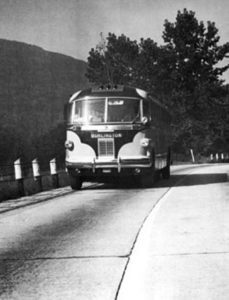Human beings have always venerated mountains. Many cultures have sacred mountains or their gods choose to live on top of one. Even temples and tombs often take their appearance from the piled up crags. Think of Mayan pyramids, Buddhist stupas, or Catholic cathedrals with their sheer walls and groined interiors, like the deepest sacred caves. We put our monsters in mountain recesses as well as our gods — Count Dracula’s impressive castle on the top of a peak in Wallachia or the Tatzelwurm curled up under a stone on the side of an Alp. One of the most mysterious mountains in the world is in the New World, in Vermont.

Glastenbury Mountain is located near Bennington, Vermont in the Green Mountains. Almost 4,000 feet in elevation, it is heavily wooded and is the source of many rivers. It has never had a very good reputation. Even among the Native Peoples, the area now known as Glastenbury Mountain was not frequented except for the ceremonial disposing of their dead. They told tales of bear-like men who would follow people through the forest, unperceived except by their footsteps that echoed a traveler’s, only to catch them up and squeeze them to death. They also spoke of a rock that looked like any other until an unwary person stepped on it when it would open and drop them into a bottomless pit, never to be seen again.
The area was empty until the Green Gold that blanketed the hillsides called to the newcomers to America. Logging began in earnest. Two towns grew up; Glastenbury and Fayville. Close as the crow flies, they were separated by a ridge of the mountains and there was little contact between them. By 1880, approximately 240 people made a life in Glastenbury, with a school and a post office. But two murders, one in Fayville in 1892, the other in Glastenbury in 1897, began the long, slow degradation of the towns’ reputations.
Of course, in those days, in a small village, there wasn’t a lot to do. The mountains would seem to close in, especially in winter. Alcohol might be a solace that turned into a crutch. In April 1892, a mill hand bashed another man over the head with a rock and fled. When he was captured, he claimed voices in his head wouldn’t leave him alone. He was sentenced to an asylum, but escaped and soon rumors flew that he had returned to the mountains. He wasn’t the only ‘wild man’ who was rumored to live there. There’d been sightings of such men since the middle of the 19th century, one of whom may have attacked a stagecoach. Such sightings have given rise to the notion of a ‘Bennington Monster’.
At the start of the hunting season, in 1897, a well-respected local man was found shot. Though family members had heard the blast, they could not find him until the next day. His body had been moved, his still loaded gun placed carefully beside him. But the perpetrator was never discovered.
The town hung on until that same year. The over-logging of the area had killed that industry, though the train tracks that had moved the logs down the mountain still operated. Someone had the bright idea of turning the town into a tourist attraction. The last years of the 19th century had prompted a great interest in the Wild Places of the United States, thanks in part to Teddy Roosevelt. So a great deal of money was spent in Glastenbury, fixing up the old mining camps, turning the industrial railway into a tram, and during the first summer all went well.
But the over-logging had ruined the mountain’s natural run-off and exceptionally heavy rains destroyed the tram-line and washed away the town’s future. By the 1930’s, 3 people lived there. All was quiet.

The Long Trail of the Green Mountains runs through the region, linking up with the Appalachian Trail, coming up from the south. As the decades wore on, guides led tours for hunters, fishermen and hikers through the beautiful region. The woods re-grew, thick and wild. Maybe that alone explains the disappearances that began in 1945, for even experienced and knowledgeable woodsmen can become disoriented and confused in the trackless woods of the Green Mountains.
Such a man was Maddie Rivers. At 74 years of age, he’d been a guide most of his life. Leading a party of four hunters, he went off on his own, promising to be back by lunch. He was never seen again. Of course, there are more than 36 square miles of territory and one man is a very small thing among all those rocks and trees. A heart attack could lay a man under bushes or ferns and his body might never be found.
However, there have been more than one disappearance on the mountain and some of them are not so easy to explain. The most famous is the vanishing of Paula Welden, an 18 year old student at Bennington College. At 2:45 pm on December 1, 1946, she decided to leave the college and go up to walk a little way along the Long Trail. She hitchhiked to the location, the driver letting her out on Rt. 9. She entered the trail at approximately 4 p.m. Waving merrily from the path, she went around a bend in her bright red coat. By the time the walkers behind her came around the same bend, only a few minutes later, she was gone…forever. 1,000 searchers, helicopters, and bloodhounds looked for her and found nothing.

What strikes me about the Welden disappearance is the timing. Sunset in Vermont on December 1st, 1946 would be approximately 4:15 pm. She traveled up to the trail, knowing that it would be dark very shortly after she arrived. Why go all that way for a ‘walk’ when she could have walked around campus? My personal belief is that Miss Welden never went to the trail at all, but died or was kidnapped earlier, possibly as soon as she left her dormitory. All we know is that a young woman in a similar red coat went up the trail…but if she removed the highly noticeable coat, who would notice her leaving? There is no evidence Miss Welden ever went there at all, except for the testimony of the driver who dropped her off and he did not know her before that day.
Four years later, the same tale of disappearance and fruitless hunt would be repeated in October of 1950 when an 8 year old boy also went missing in the same location.
The quality of the search for Miss Welden had been roundly criticized and eventually the Vermont State Police came into being because of it. But nevertheless no one found young Paul Jepson, left alone for just a few moments in their car by his mother. Bloodhounds traced him as far as the highway, but what made a young boy walk away in the first place? His father said that Paul had been expressing a powerful ‘yen’ to head up the mountain for some days before his disappearance. Had he given in to it?
Two weeks after Paul vanished, another person disappeared in the woods. Frieda Langer, 53, was an experienced camper, thoroughly familiar with the area. Hiking with her cousin, she slipped into a creek. Realizing how dangerous wet clothes could be in the chill of the fall, she said she’d go back to camp, change, and return within half an hour. Her cousin waited by the stream but Frieda not only never came back, she’d never returned to the campsite. Somewhere in the half mile between where she got wet and the camp, she’d disappeared. Again, a thorough search found nothing…until 7 months later when her remains were found in an open field, a field that had been searched more than once since her disappearance. Her body was in such a condition that means of death were undiscoverable.
An earlier death, in November of 1943, is possibly linked to these others, except that the body of Carl Herrick was found within three days of his disappearance. He’d been hunting with his cousin, Henry, when the men became separated. Henry returned to camp; Carl didn’t. He contacted searchers immediately and eventually was the one to find Carl. The cause of death was macabre. He’d been squeezed to death, stabbed in the lungs with his own ribs. Henry reported bear tracks around the body but whether a bear was responsible or just investigating the body is unknown.

The most mysterious disappearance of all…of retired soldier off a Bennington bus is perhaps in actuality the least mysterious. James Tetford was returning to the Bennington Soldiers Home from a visit up north when he was eventually reported as missing. Though no one remembered seeing him, it soon was rumored that he’d gotten on the bus but never gotten off it, in effect disappearing from the middle of a moving vehicle. However, he may have gotten off near Rt 9…or perhaps elsewhere unremarked and unnoticed. At any rate, he too was never located.
So what did happen in those late fall/early winter months between 1945 and 1950? To the modern mind, raised on movies, books, and newspaper accounts of ‘serial killers’, it seems obvious that a murderer was active on the mountain. But there are objections to that theory. Serial killers are usually much more discriminating, choosing victims with similarities of feature or behavior. But people ranging from an 8 year old boy to a middle-aged woman to an elderly hunting guide don’t have much in common. Could there have been some kind of wild animal who’d developed a taste for human flesh? There are reports of mountain lions living in the forests even today. There are also reports, however believable or not, of frequent UFO activity up in the Green Mountains.

For me, I believe that there is little reason to connect any of these events. But human beings demand patterns. We look at clouds and see faces, or animals, or whatever we are thinking of. They aren’t there…but we see them. The same drive makes us say because A, B, and C took place in the same area or at a similar time they must therefore be linked. But this is not true. Randomness must be considered.
People, even experienced wilderness trekkers, get lost. I’ve been lost in the mountains of Arizona, among the featureless rocks and disappearing trails. I can only imagine it’s worse among the trees, which block any kind of long view . Panic can set in so easily – a fear of the wild known to ancient people – and some have been known to ‘argue’ with their compasses, so sure that they know where they are and that the compass is ‘wrong’ that they become even more confused and lost. Sometimes they are eventually found only a hundred yards or so from a trail and safety. People have heart attacks. People tell stories, some true, some not, or embellish the ones they know to create patterns in behavior and actions.
Thousands of people go to the Green Mountains every year, more all the time as hiking and out-doors activities become ever more popular. If ‘something is going on’, mysterious incidents should still be reported. But except for some reports of ‘odd weather’ or ‘sudden storms’, not at all unusual in the mountains, there haven’t been anything new. If ‘something’ was happening in the 1940’s and ’50’s…it is over.
However, if you should go there, and your beloved says ‘stand on this rock while I take your picture’…don’t do it.